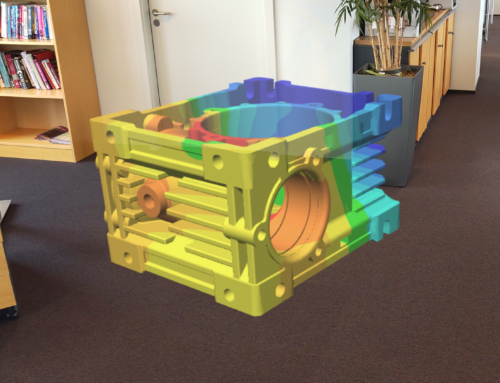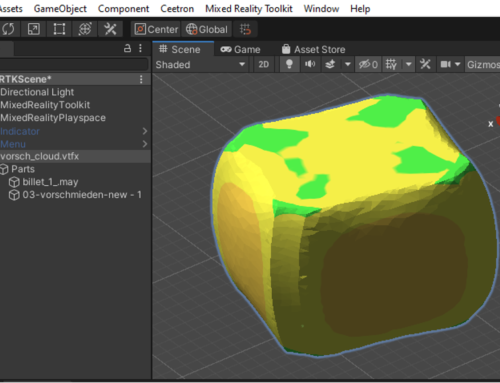(08.05.19) My colleague Frode Brandt just came back from Redmond after having attended Microsoft mixed reality dev days on May 2-3. He was brimming with enthusiasm for the device, being Ceetron’s key guy in the areas virtual reality, augmented reality, and mixed reality. The same enthusiasm for HoloLens has been repeatedly expressed by some of our absolutely largest OEM customers in CAE space over the last 1 or 2 years. This is why I wanted to share with you some of the content of Frode’s trip report in the form of this blog post.
First a couple of words about the event: May 2-3, building 92 on MS’ campus in Redmond (picture on the left), around 1 000 attendees from all over the world, by invitation only. No headsets available in the market at the time of the event, though Technical Fellow Don Box from MS on May 2 announced availability of a developer edition later 2019 for USD 3 500. I will get back to the availability issue later in this blog post.
Impressions on Microsoft’s mixed reality dev days
Q1: In what way is HoloLens 2 different from HoloLens 1?
Frode: FOV (Field of View) of HoloLens 2 is better than the one in HoloLens 1, but needs improvement in both directions (my comment: 52 degrees vs. 35 degrees, diagonally, unconfirmed). That said, it is now in a usable state. Resolution at 47 pixels per degree is OK, but no more that. Rendering speed may be a problem for more ‘heavy’ models. This will of course improve, but an increased resolution and FOV will make this harder to do. Their solution is Azure Remote Rendering. HoloLens 1, which in my head was an advanced prototype, has been redesigned to look and feel more like a commercial product in HoloLens 2. The headset is quite comfortable to wear.
Q2: What did MS say about device availability?
Frode: Developers are of course screaming for hardware. But it will still take some time to get hold of a HoloLens 2, especially for people outside selected countries (US, France, Germany, Ireland, New Zealand, Australia, and UK). One reason, according to MS, is that HoloLens 2 has not yet been approved by authorities in quite a few countries. I personally suspect manufacturing issues or limited-scale market testing, though.

Q3: What use cases were described by MS?
Frode: MS representatives talked repeatedly about digital twins and IoT. In automotive, they referred to use cases in design experience, training and guidance, sales & marketing, HMI for non-ISO 26262 applications and auto simulation (for autonomous systems). In architecture, engineering, and construction, they talked about design and data viz, sales and marketing (again), and training and safety. It was all about HoloLensin combination with services in the cloud, including AI services in the cloud.
Q4: Any industry insight you could share with our readers based on your conversations in Redmond regarding the larger ecosystem of which HoloLens is part?
Frode: Unity is partnering with MS, and they seem to go all in on virtual reality, augmented reality and mixed reality. Besides, they currently have an offer in which they bundle 3 months of professional use for HoloLens 2 developers. PiXYZ is an interesting plug-in offering for bringing CAD data into Unity. Moreover, regarding standards, Alex Kipman, Technical Fellow at MS, has previously announced that MS is releasing a developer preview of OpenXR runtime with support for Windows mixed reality headsets.
HoloLens for CAE, FEA or CFD professionals?
My conversation with Frode addressed only marginally the core of the matter for the CAE community: Is HoloLens a good device for CAE, for FEA or CFD professionals? To look more into this matter I did a thorough read of a recent article in The Verge by Dieter Bohn (source). Here is what Dieter said: “The HoloLens 2 is only being sold to corporations, not to consumers. It’s designed for what Kipman calls “first-line workers,” people in auto shops, factory floors, operating rooms, and out in the field fixing stuff. It’s designed for people who work with their hands and find it difficult to integrate a computer or smartphone into their daily work. Kipman wants to replace the grease-stained Windows 2000 computer sitting in the corner of the workroom.” He is explicit that HoloLens is not for knowledge workers.
So if you read CAE as heavy duty knowledge work by a Ph.D. in mechanical engineering doing complex simulation work in his personal office, it does not seem like HoloLens is the right choice (and you may instead want to take a look at say Oculus Rift, for which we have a free viewer). Indeed, one would probably look for VR devices with better immersive and collaborative capabilities, and better technical specs. On the other hand, if you think that there is a significant role for numerical simulation in first-line work, like for example MRO (maintenance, repair, operations) or surgical procedures, HoloLens could be a perfect fit.
In Ceetron, we aspire to be leading provider of 3D viz for CAE based on virtual reality, augmented reality, and mixed reality, across headsets and devices. If you want to set up a WebEx with Frode or Fredrik Viken, our CTO, to discuss your needs in these areas, feel free to contact me at grim.gjonnes@ceetron.com.
By the way, Frode is busy trying to work around the country-specific preordering restrictions referred to above.
Grim
Head S&M in Ceetron








Leave A Comment
You must be logged in to post a comment.